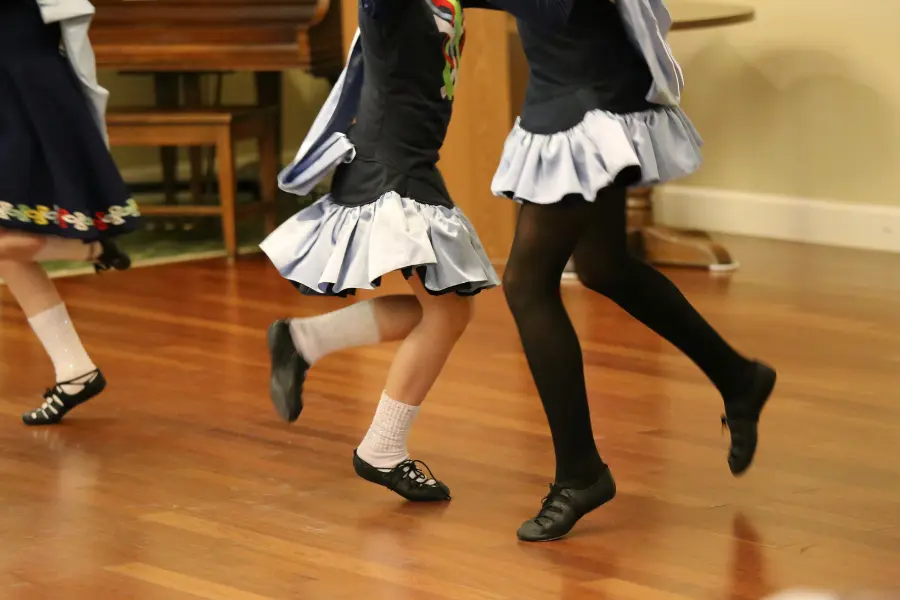Irish dance is a captivating and rhythmic art form that demands precision, strength, and flexibility. However, like any physical activity, it comes with the risk of injuries. In this blog, we’ll delve into some of the most common injuries faced by Irish dancers and provide insights on prevention and management.
When it comes to Irish dance, the stage becomes a canvas of elegance and vigor, where dancers tell stories through their feet. This ancient dance form has its own set of demands that dancers must conquer to excel. Let’s dive into the world of Irish dance and unravel the distinct physical challenges that define this captivating art:

Unveiling the Intricacies of Footwork: The Heartbeat of Irish Dance
Every tap, every step in Irish dance is a testament to the dancer’s skill and precision. The intricate footwork, known as “battering,” is the lifeblood of this art. Dancers use their feet like drumsticks, creating a rhythm that echoes through the audience. The complexity of footwork places unique strains on the lower limbs, demanding both strength and finesse.
Taking Flight: The Art of Jumps and Leaps
Irish dance isn’t just about the ground—it’s about soaring through the air with seemingly effortless grace. The jumps and leaps are a dazzling display of athleticism, demanding explosive power and impeccable control. From the intricate “clicks” to the soaring “overheads,” Irish dancers challenge gravity and physics with each leap. But with great elevation comes the risk of landing, which underscores the importance of injury prevention techniques.
The Posture Paradox: Finding Balance Amid Elegance
Irish dancers are known for their impeccable posture, which lends an air of regality to their performances. The paradox lies in the fact that while the dancers appear poised and elegant, maintaining this posture requires core strength and endurance. The upright stance, combined with dynamic movements, can lead to back and core muscle imbalances if not properly addressed.
Common Injuries in Irish Dancers:
-
Stress Fractures
The repetitive impact placed on the feet and legs during Irish dance can lead to stress fractures, small cracks in the bones. These fractures often develop gradually due to overuse and inadequate rest.
Early Signs and Symptoms: Dancers should watch out for localized pain, tenderness, and swelling, especially during or after dance sessions.
Prevention Techniques: To prevent stress fractures, dancers should invest in proper footwear that provides adequate support. Gradually increasing training intensity and incorporating cross-training activities, such as swimming or cycling, can also reduce the risk.
-
Ankle Sprains
The swift direction changes and energetic footwork in Irish dance can make dancers susceptible to ankle sprains. The abrupt shifts in weight and balance put stress on the ligaments.
Strengthening and Stability: Ankle strengthening exercises and balance training play a pivotal role in preventing future ankle sprains. Strong ankle muscles provide greater stability during complex dance movements.
Warm-Ups and Cool-Downs: A thorough warm-up before practice and a proper cool-down routine afterward can reduce the likelihood of ankle injuries. These routines increase blood flow and prepare the muscles and ligaments for movement.
-
FHL Tendonitis
The dynamic leaps and jumps characteristic of Irish dance can lead to strain on the Flexor Hallucis Longus (FHL) tendon, which runs along the back of the ankle.
Strengthening and Stretching: Dancers can alleviate FHL tendonitis through calf-strengthening exercises and targeted stretches. These exercises promote tendon health and flexibility.
Progressive Training: Gradually increasing the intensity and complexity of dance routines is essential to avoid overburdening the FHL tendon. Proper progression minimizes the risk of tendonitis.
-
Sever’s Disease
Sever’s disease, also known as calcaneal apophysitis, primarily affects young dancers. It involves inflammation in the growth plate of the heel bone.
Pain Indicators: Dancers may experience heel pain during and after dancing, particularly during growth spurts. This condition is common among adolescents.
Preventive Measures: Rest is crucial to manage Sever’s disease. Proper footwear with cushioning can help alleviate discomfort. Supportive shoes and orthotic inserts can provide additional relief.
-
Snapping Hip Syndrome
Snapping hip syndrome is characterized by a snapping or popping sensation in the hip joint during movement.
Causes and Movements: Certain dance movements, such as high kicks or rapid leg extensions, can contribute to the snapping hip sensation.
Stretching and Strengthening: Specific stretches and exercises can help address muscle imbalances that contribute to snapping hip syndrome. Strengthening the hip muscles can also provide relief.
-
Sesamoiditis
The sesamoid bones, located under the big toe joint, can experience stress from the demands of Irish dance.
Symptoms and Impact: Dancers may feel pain under the big toe, particularly during dance activities. Sesamoiditis can impact their ability to perform and enjoy dance.
Care and Relief: Rest and avoiding activities that exacerbate the pain are essential. Proper footwear with cushioning and padding can alleviate pressure on the sesamoid bones.
Ready to Dance Pain-Free? Schedule Your Consultation Today!
Here at PREP Performance Center we specialize in helping dancers stay on their feet and excel in their passion. Our experienced team of physical therapists understands the unique challenges dancers face and is dedicated to providing personalized care to prevent and manage injuries. Whether you’re dealing with stress fractures, ankle sprains, or any other dance-related injury, we’re here to support you on your journey to optimal performance and well-being.
Don’t let injuries hold you back from the joy of Irish dance. Contact us now to book your consultation and take the first step towards dancing confidently and pain-free. Let us be your partner in achieving your dance goals while prioritizing your health.
Call today or schedule your individual phone consultation with a Doctor of Physical Therapy. You may also book for an appointment today.


